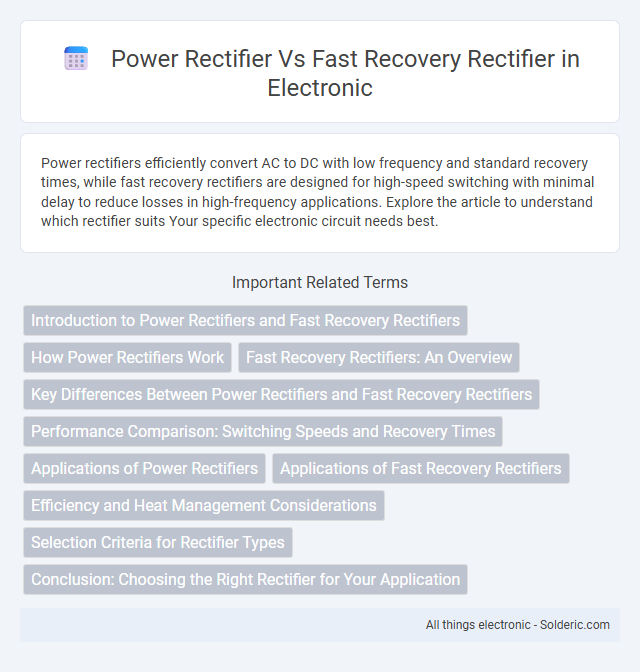Power rectifiers efficiently convert AC to DC with low frequency and standard recovery times, while fast recovery rectifiers are designed for high-speed switching with minimal delay to reduce losses in high-frequency applications. Explore the article to understand which rectifier suits Your specific electronic circuit needs best.
Comparison Table
| Feature | Power Rectifier | Fast Recovery Rectifier |
|---|---|---|
| Switching Speed | Slower recovery time | Very fast recovery time |
| Recovery Time | Typically in microseconds (us) | Typically in nanoseconds (ns) |
| Application | High power conversion, industrial power supplies | High-frequency switching power supplies, inverters |
| Efficiency | Lower at high frequencies | Higher at high switching frequencies |
| Forward Voltage Drop | Higher | Lower |
| Cost | Generally lower | Generally higher |
| Suitability | Best for low-frequency, high-current applications | Best for high-frequency, fast switching applications |
| Heat Dissipation | Higher due to slower switching | Lower due to faster recovery |
Introduction to Power Rectifiers and Fast Recovery Rectifiers
Power rectifiers are semiconductor devices designed to convert alternating current (AC) to direct current (DC) with high efficiency and robustness for applications like power supplies and motor drives. Fast recovery rectifiers, a specialized type of power rectifier, feature significantly reduced reverse recovery times, allowing for improved performance in high-frequency switching circuits and reduced switching losses. Selecting between power rectifiers and fast recovery rectifiers depends on factors such as switching speed requirements, power handling capacity, and application-specific efficiency demands.
How Power Rectifiers Work
Power rectifiers convert alternating current (AC) to direct current (DC) by allowing current flow primarily in one direction through semiconductor diodes, effectively blocking reverse current. They operate with slower switching speeds, making them suitable for applications where high efficiency at low frequencies is critical. The controlled conduction and high current capacity distinguish power rectifiers from fast recovery rectifiers, which emphasize rapid switching for high-frequency circuits.
Fast Recovery Rectifiers: An Overview
Fast recovery rectifiers feature rapid reverse recovery times typically under 500 nanoseconds, significantly reducing switching losses in high-frequency applications. These diodes utilize advanced semiconductor materials like silicon carbide or optimized silicon structures to achieve low forward voltage drops and enhanced efficiency. Their performance benefits are critical in power supplies, inverter circuits, and motor drives where minimizing electromagnetic interference and heat generation is essential.
Key Differences Between Power Rectifiers and Fast Recovery Rectifiers
Power rectifiers are designed for handling high voltage and current in applications such as power supplies and motor drives, offering robust durability and efficiency under continuous conduction. Fast recovery rectifiers feature a significantly reduced reverse recovery time, making them ideal for high-frequency switching circuits where minimizing switching losses and electromagnetic interference is critical. Key differences include recovery time, switching speed, and application suitability, with power rectifiers prioritizing heavy load endurance and fast recovery rectifiers optimizing speed and efficiency in rapid switching environments.
Performance Comparison: Switching Speeds and Recovery Times
Power rectifiers typically exhibit slower switching speeds and longer recovery times, making them suitable for high current, low frequency applications where efficiency is less critical. Fast recovery rectifiers feature significantly reduced recovery times, often in the nanosecond range, enabling superior performance in high frequency circuits by minimizing switching losses and electromagnetic interference. The choice between these rectifiers hinges on the application's frequency requirements and efficiency goals, with fast recovery diodes preferred in modern power supplies and inverter designs.
Applications of Power Rectifiers
Power rectifiers are widely used in high-voltage direct current (HVDC) transmission systems, industrial motor drives, and power supply units where efficient conversion of AC to DC is crucial. They serve critical roles in battery charging, welding equipment, and uninterruptible power supplies (UPS) due to their ability to handle large currents and voltages. Power rectifiers ensure stable and reliable DC output in applications requiring robust and continuous power delivery.
Applications of Fast Recovery Rectifiers
Fast recovery rectifiers are commonly used in high-frequency switching power supplies, inverters, and motor drives due to their ability to minimize reverse recovery time and reduce switching losses. These rectifiers are essential in applications requiring efficient energy conversion and fast switching, such as in renewable energy systems and electric vehicle controllers. Your designs benefit from improved efficiency and reliability when utilizing fast recovery rectifiers in high-speed and high-frequency circuits.
Efficiency and Heat Management Considerations
Power rectifiers generally offer robust efficiency and moderate heat generation suitable for high-current applications, while fast recovery rectifiers optimize efficiency by minimizing reverse recovery time, reducing switching losses and heat buildup. Your choice impacts thermal management strategies, as fast recovery rectifiers enable improved cooling performance and potentially smaller heat sinks, enhancing overall system reliability. Selecting the appropriate rectifier type ensures efficient energy conversion and effective heat dissipation tailored to your application's dynamic switching requirements.
Selection Criteria for Rectifier Types
Power rectifiers are selected for applications requiring high current and voltage handling with efficiency prioritized in steady-state power conversion, whereas fast recovery rectifiers are favored in high-frequency switching environments due to their ability to quickly cease conduction and reduce switching losses. The choice depends on parameters such as switching speed, reverse recovery time, forward voltage drop, and thermal management requirements, making power rectifiers ideal for low-frequency, high-power applications, and fast recovery rectifiers suited for fast-switching power supplies and inverters. Electrical engineers must evaluate load characteristics, switching frequency, and efficiency demands to determine the optimal rectifier type for reliable and efficient circuit performance.
Conclusion: Choosing the Right Rectifier for Your Application
Selecting the right rectifier depends on the specific requirements of your application, with power rectifiers excelling in high current and voltage environments due to their robust construction and efficient heat dissipation. Fast recovery rectifiers are optimal for applications requiring rapid switching speeds and minimized reverse recovery time, such as in high-frequency circuits and inverter designs. Evaluate factors like switching frequency, efficiency needs, thermal performance, and cost to determine whether a power rectifier or fast recovery rectifier best aligns with your system's operational demands.
Power rectifier vs Fast recovery rectifier Infographic

 solderic.com
solderic.com